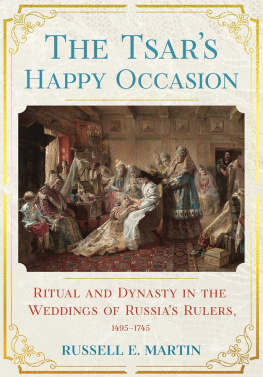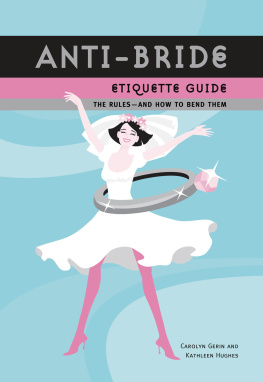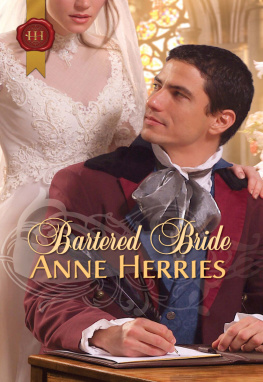Russell E. Martin - A Bride for the Tsar: Bride-Shows and Marriage Politics in Early Modern Russia
Here you can read online Russell E. Martin - A Bride for the Tsar: Bride-Shows and Marriage Politics in Early Modern Russia full text of the book (entire story) in english for free. Download pdf and epub, get meaning, cover and reviews about this ebook. year: 2012, publisher: Northern Illinois University Press, genre: Home and family. Description of the work, (preface) as well as reviews are available. Best literature library LitArk.com created for fans of good reading and offers a wide selection of genres:
Romance novel
Science fiction
Adventure
Detective
Science
History
Home and family
Prose
Art
Politics
Computer
Non-fiction
Religion
Business
Children
Humor
Choose a favorite category and find really read worthwhile books. Enjoy immersion in the world of imagination, feel the emotions of the characters or learn something new for yourself, make an fascinating discovery.

- Book:A Bride for the Tsar: Bride-Shows and Marriage Politics in Early Modern Russia
- Author:
- Publisher:Northern Illinois University Press
- Genre:
- Year:2012
- Rating:5 / 5
- Favourites:Add to favourites
- Your mark:
- 100
- 1
- 2
- 3
- 4
- 5
A Bride for the Tsar: Bride-Shows and Marriage Politics in Early Modern Russia: summary, description and annotation
We offer to read an annotation, description, summary or preface (depends on what the author of the book "A Bride for the Tsar: Bride-Shows and Marriage Politics in Early Modern Russia" wrote himself). If you haven't found the necessary information about the book — write in the comments, we will try to find it.
Russell E. Martin: author's other books
Who wrote A Bride for the Tsar: Bride-Shows and Marriage Politics in Early Modern Russia? Find out the surname, the name of the author of the book and a list of all author's works by series.
A Bride for the Tsar: Bride-Shows and Marriage Politics in Early Modern Russia — read online for free the complete book (whole text) full work
Below is the text of the book, divided by pages. System saving the place of the last page read, allows you to conveniently read the book "A Bride for the Tsar: Bride-Shows and Marriage Politics in Early Modern Russia" online for free, without having to search again every time where you left off. Put a bookmark, and you can go to the page where you finished reading at any time.
Font size:
Interval:
Bookmark:

2012 by Northern Illinois University Press
Published by the Northern Illinois University Press, DeKalb, Illinois 60115
Manufactured in the United States using acid-free paper.
All Rights Reserved
Design by Julia Fauci
Library of Congress Cataloging-in-Publication Data
Martin, Russell, 1963
A bride for the Tsar: bride-shows and marriage politics in early modern Russia /
Russell E. Martin.
pages ; cm
Includes bibliographical references and index.
ISBN 978-0-87580-448-4 (hardcover : alkaline paper)
ISBN 978-1-60909-054-8 (electronic)
1. Marriages of royalty and nobilityRussiaHistory16th century. 2. Marriages of royalty and nobilityRussiaHistory17th century. 3. Marriages of royalty and nobilityPolitical aspectsRussia. 4. Bride showsRussiaHistory16th century.
5. Bride showsRussiaHistory17th century. 6. Marriage customs and rites
RussiaHistory16th century. 7. Marriage customs and ritesRussiaHistory
17th century. I. Title.
GT2756.A2M37 2012
392.5086210947dc2
2011043203
Photo section images courtesy of Wikimedia Commons.
Contents
Acknowledgments ix
Note on Dates, Names, and Transliteration xiii
Introduction
It Would Be Best to Marry the Daughter of One of His Subjects
The Origins of the Bride-Show in Muscovy
Without Any Regard for Noble Ancestry
Picking a Bride for the Tsar
If You Marry a Second Time, You Will Have an Evil Child Born to You Bride-Shows and Muscovite Political Culture
To Assuage the Melancholy The Many Wives of Ivan IV
Scheming to Be Rid of the Chosen Tsarevna
Conflict and Conspiracy in the Romanov Bride-Shows
Worthy because the Tsar Adores You
The Last Bride-Shows and the Return of Foreign-Born Brides
Epilogue
Appendices
A Excerpts from the Chronograph of the Marriages of Tsar Ivan Vasilevich
BCandidates at the Bride-Shows for Tsar Aleksei Mikhailovich, 16701671
CGifts Given to Candidates in the Bride-Show for Fedor Alekseevich, 1680
DGenealogies
Abbreviations
Notes
Bibliography
Index
Acknowledgments
The happiest, easiest, and most gratifying part of this project has been to compose these paragraphs thanking the many institutions and people that have assisted me in researching and writing this book. I have received grants from the Social Science Research Council (SSRC), the International Research and Exchanges Board (IREX), and Westminster College (including endowed funds from the Henderson, McCandless, and Watto families), which supported my lengthy and numerous trips to archives in Russia. I am deeply grateful to these agencies and to my employer for their financial support.
My interest in Muscovite royal weddings began in the archives when I opened a folder at the Russian State Archive of Ancient Acts (RGADA) in Moscow, which contained a jumbled collection of random phrases and bits of unedited text from the ceremonial ( svadebnyi chin ) for Tsar Mikhail Romanovs first wedding in 1624 (RGADA, fond 135, section IV, rubric II, number 14). The rich and untapped potential of this source was plain to me at first glance, and so I immediately set out to collect every original and early copy of royal wedding documentation I could lay my hands on. I succeeded in finding and handling what I believe is the full corpus of extant original wedding texts thanks to the help of the capable and selfless staff of RGADA, the primary repository for these materials. I acquired a deep affection for this archivethe creaking floorboards, the grooves worn into the stone staircases, the wood and glass cases full of well-worn typed or handwritten inventories, the ubiquitous cats. I found it the most convivial place to work and, just as important, to establish friendships and collaborations with Russian colleagues. I particularly thank Iurii Moiseevich Eskin, Ideia Andreevna Balakaeva, and Svetlana Romanovna Dolgova. I also acknowledge and am grateful for the assistance offered to me by RGADAs former director, the greatly missed Mikhail Petrovich Lukichev, who was taken from us far too soon. I spent many months working in or obtaining materials from other manuscript repositories as well, including the Manuscript Division of the Russian State Library (RGB, Moscow), the State Historical Museum (GIM, Moscow), the Archive of the Russian Academy of Sciences (ARAN, Moscow), the Russian State Historical Archive (RGIA, St. Petersburg), the Manuscript Division of the Russian National Library (RNB, St. Petersburg), the Library of the Academy of Sciences (BAN, St. Petersburg), the Military-Historical Museum of Artillery, Engineers, and Communications Forces (VIMAIViVS, St. Petersburg), and the Iaroslav Regional Library (IaOB, Iaroslav). I thank the professional staffs of all these institutions, who offered me assistance and advice happily, efficiently, and unstintingly.
Many otherscolleagues, friends, and familyalso played a role in the completion of this project, and I hasten to add their names to this tabula gratiarum . I must thank first and foremost my dear friend Boris Nikolaevich Morozov (Archeographical Commission, Moscow), who lent me his time and expertise again and again over the course of many years. If there is anything new and useful in this book, it is because of his unmatched familiarity with the archives and his willingness to share, advise, encourage, and assist. Olga Evgenevna Kosheleva (RGADA) has also been for many years a dear and esteemed friend, whose sound advice, expertise with archival materials, critical eye, and sense of humor I have come to rely upon during my research on this and many other projects. Others in various ways also lent me their advice and assistance, for which I am deeply grateful: Nancy Shields Kollmann, Sergei Bogatyrev, Michael Flier, Daniel Rowland, Chester Dunning, Charles Halperin, David Goldfrank, Robert Crummey, Aleksei Ivanovich Alekseev, Vladislav Dmitreevich Nazarov, Andrei Pavlovich Pavlov, Iurii Vladimirovich Ankhimiuk, Irina Aleksandrovna Voznesenskaia, Ludwig Steindorff, Jennifer Spock, Marina Swoboda, Ernest Zitser, Marshall Poe, Orysia Karapinka, A. Dwight Castro, Bryan Rennie, Connie Davis, Eric Forster, Nathan Carlin, Jillian Maniscarco, Sandra Webster, Robert Monyak, John Deegan, Brien Horan, and of blessed memory, Richard Hellie and Oscar Remick. I also thank Amy Farranto and Susan Bean of Northern Illinois University Press, whose professionalism and skill have made the entire experience of producing this book an utter pleasure.
This project plainly displays the influence of two of my intellectual mentors. The first is Edward Keenan, with whom I worked as a graduate student and whose ideas about power and political culture continue to influence my own thinking about the way Muscovy worked. Neds provocative heresies have inspired and emboldened me to make my own venturesome claims about court politics in Muscovy; and while he may not agree with every argument advanced in the pages that follow, I hope this work meets his own high standards of erudition. The other is Donald Ostrowski. Our hours at Peets Coffee House in Harvard Square discussing early Russian history have been among my most satisfying intellectual experiences since leaving Harvard fifteen years ago. During one of these intense sessions, Don suggested: Youve done so much on bride-shows, why dont you just write a book about them? I had not thought to pull together the many strands of my thinking into a focused book-length work until that moment, but I was hard at work on it within hours of that meeting. I am grateful for Dons constant support and advice over the years, but mostly for his generous and warm friendship. I am hardly the only one who has benefited from his advice and encouragement, but I am among the most grateful for it.
Next pageFont size:
Interval:
Bookmark:
Similar books «A Bride for the Tsar: Bride-Shows and Marriage Politics in Early Modern Russia»
Look at similar books to A Bride for the Tsar: Bride-Shows and Marriage Politics in Early Modern Russia. We have selected literature similar in name and meaning in the hope of providing readers with more options to find new, interesting, not yet read works.
Discussion, reviews of the book A Bride for the Tsar: Bride-Shows and Marriage Politics in Early Modern Russia and just readers' own opinions. Leave your comments, write what you think about the work, its meaning or the main characters. Specify what exactly you liked and what you didn't like, and why you think so.







